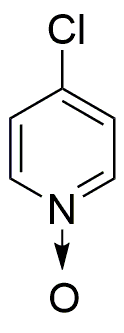4-Chloropyridine N-oxide is widely utilized in research focused on:
- Synthesis of Pharmaceuticals: This compound serves as an important intermediate in the synthesis of various pharmaceuticals, particularly in the development of anti-inflammatory and antimicrobial agents.
- Agricultural Chemicals: It is used in the formulation of agrochemicals, enhancing the efficacy of pesticides and herbicides, thereby improving crop yield and pest management.
- Organic Synthesis: Researchers leverage its unique properties in organic synthesis reactions, particularly in the creation of complex organic molecules, which are essential in materials science and chemical engineering.
- Analytical Chemistry: This compound acts as a reagent in analytical methods, aiding in the detection and quantification of various substances, which is crucial for quality control in laboratories.
- Research in Material Science: It is explored for its potential applications in developing new materials, such as conductive polymers and coatings, which can enhance the performance of electronic devices.
Informations générales
Propriétés
Sécurité et réglementation
Applications
4-Chloropyridine N-oxide is widely utilized in research focused on:
- Synthesis of Pharmaceuticals: This compound serves as an important intermediate in the synthesis of various pharmaceuticals, particularly in the development of anti-inflammatory and antimicrobial agents.
- Agricultural Chemicals: It is used in the formulation of agrochemicals, enhancing the efficacy of pesticides and herbicides, thereby improving crop yield and pest management.
- Organic Synthesis: Researchers leverage its unique properties in organic synthesis reactions, particularly in the creation of complex organic molecules, which are essential in materials science and chemical engineering.
- Analytical Chemistry: This compound acts as a reagent in analytical methods, aiding in the detection and quantification of various substances, which is crucial for quality control in laboratories.
- Research in Material Science: It is explored for its potential applications in developing new materials, such as conductive polymers and coatings, which can enhance the performance of electronic devices.
Documents
Fiches de données de sécurité (FDS)
La FDS fournit des informations de sécurité complètes sur la manipulation, le stockage et l’élimination du produit.
Spécifications du produit (PS)
Le PS fournit une description complète des propriétés du produit, notamment sa composition chimique, son état physique, sa pureté et les exigences de stockage. Il détaille également les plages de qualité acceptables et les applications prévues du produit.
Certificats d'analyse (COA)
Recherchez des certificats d'analyse (COA) en saisissant le numéro de lot du produit. Les numéros de lot et de lot se trouvent sur l'étiquette d'un produit, après les mots « Lot » ou « Lot de fabrication ».
Numéro de catalogue
Numéro de lot/série
Certificats d'origine (COO)
Ce certificat d'exploitation confirme le pays dans lequel le produit a été fabriqué, et détaille également les matériaux et composants utilisés et s'il est issu de sources naturelles, synthétiques ou autres sources spécifiques. Ce certificat peut être requis pour les douanes, le commerce et la conformité réglementaire.
Numéro de catalogue
Numéro de lot/série
Fiches de données de sécurité (FDS)
La FDS fournit des informations de sécurité complètes sur la manipulation, le stockage et l’élimination du produit.
DownloadSpécifications du produit (PS)
Le PS fournit une description complète des propriétés du produit, notamment sa composition chimique, son état physique, sa pureté et les exigences de stockage. Il détaille également les plages de qualité acceptables et les applications prévues du produit.
DownloadCertificats d'analyse (COA)
Recherchez des certificats d'analyse (COA) en saisissant le numéro de lot du produit. Les numéros de lot et de lot se trouvent sur l'étiquette d'un produit, après les mots « Lot » ou « Lot de fabrication ».
Numéro de catalogue
Numéro de lot/série
Certificats d'origine (COO)
Ce certificat d'exploitation confirme le pays dans lequel le produit a été fabriqué, et détaille également les matériaux et composants utilisés et s'il est issu de sources naturelles, synthétiques ou autres sources spécifiques. Ce certificat peut être requis pour les douanes, le commerce et la conformité réglementaire.


